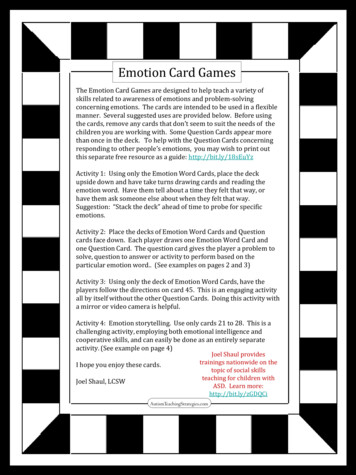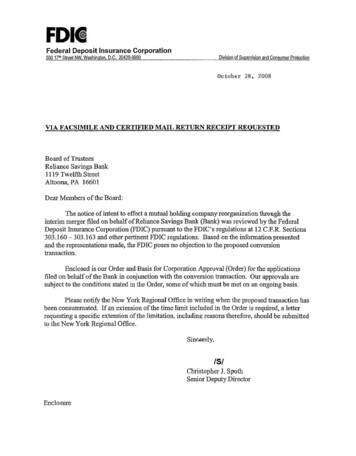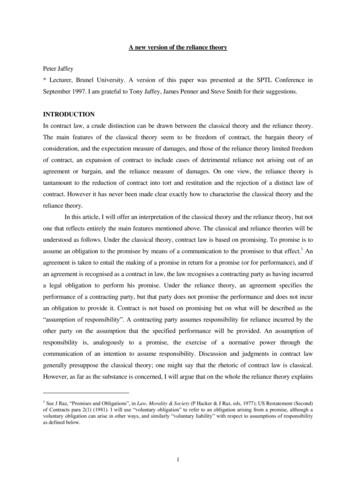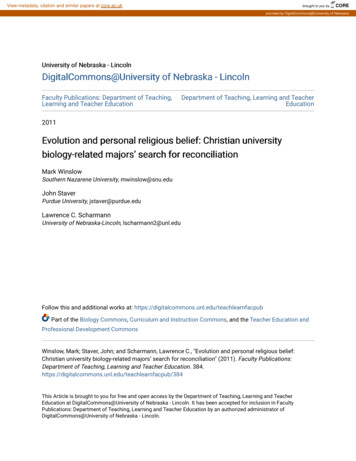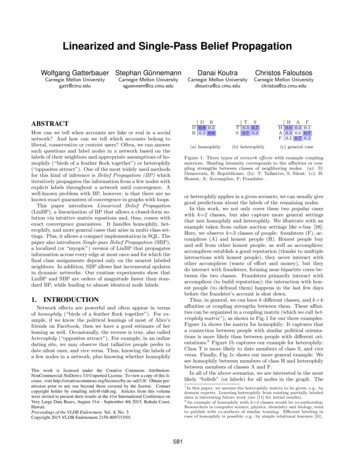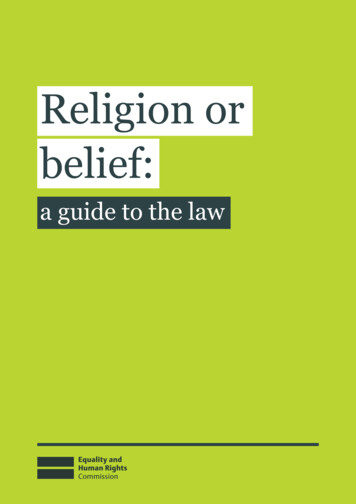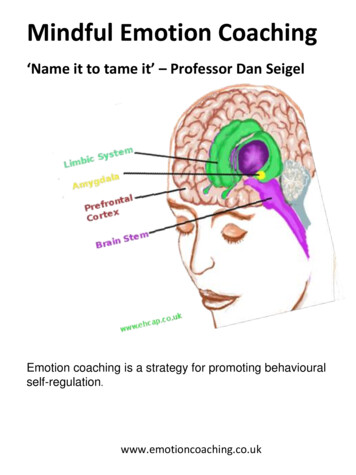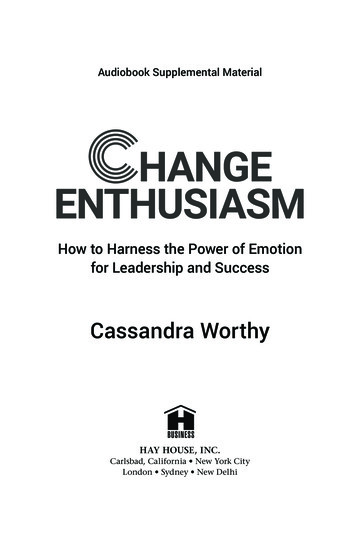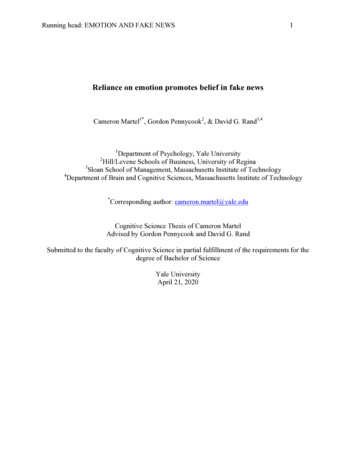
Transcription
Running head: EMOTION AND FAKE NEWS1Reliance on emotion promotes belief in fake newsCameron Martel1*, Gordon Pennycook2, & David G. Rand3,41Department of Psychology, Yale UniversityHill/Levene Schools of Business, University of Regina3Sloan School of Management, Massachusetts Institute of Technology4Department of Brain and Cognitive Sciences, Massachusetts Institute of Technology2*Corresponding author: cameron.martel@yale.eduCognitive Science Thesis of Cameron MartelAdvised by Gordon Pennycook and David G. RandSubmitted to the faculty of Cognitive Science in partial fulfillment of the requirements for thedegree of Bachelor of ScienceYale UniversityApril 21, 2020
EMOTION AND FAKE NEWS2AbstractWhat is the role of emotion in susceptibility to believing fake news? Prior work on thepsychology of misinformation has focused primarily on the extent to which reason anddeliberation hinder versus help the formation of accurate beliefs. Several studies have suggestedthat people who engage in more reasoning are less likely to fall for fake news. However, the roleof reliance on emotion in belief in fake news remains unclear. To shed light on this issue, weexplored the relationship between specific emotions and belief in fake news (Study 1; N 409).We found that across a wide range of specific emotions, heightened emotionality was predictiveof increased belief in fake (but not real) news. Then, in Study 2, we measured and manipulatedreliance on emotion versus reason across four experiments (total N 3884). We found bothcorrelational and causal evidence that reliance on emotion increases belief in fake news: Selfreported use of emotion was positively associated with belief in fake (but not real) news, andinducing reliance on emotion resulted in greater belief in fake (but not real) news storiescompared to a control or to inducing reliance on reason. These results shed light on the uniquerole that emotional processing may play in susceptibility to fake news.Keywords: fake news, misinformation, dual-process theory, emotion, reason
EMOTION AND FAKE NEWS3IntroductionThe 2016 U. S. presidential election and U. K. Brexit vote focused attention on the spreadof “fake news” (“fabricated information that mimics news media content in form but not inorganizational process or intent”; Lazer et al., 2018, p. 1094) via social media. Although thefabrication of ostensible news events has been around in media such as tabloid magazines sincethe early 20th century (Lazer et al., 2018), technological advances and the rise of social mediaprovide opportunity for anyone to create a website and publish fake news that might be seen bymany thousands (or even millions) of people. Indeed, the spread of misinformation aboutcompanies or products can have damaging financial effects. Furthermore, false rumors orconspiracy theories within organizations can disrupt productivity and severely compromiseteamwork and cooperation.The threat of misinformation is perhaps most prevalent and salient within the domain ofpolitics. It is estimated, for example, that within the three months prior to the U. S. election, fakenews stories favoring Trump were shared around 30 million times on Facebook, while thosefavoring Clinton were shared around 8 million times (Allcott & Gentzkow, 2017). Furthermore,a recent analysis suggests that among news stories fact-checked by the website Snopes.com,false stories spread farther, faster, and more broadly on Twitter than true stories, with falsepolitical stories reaching more people in a shorter period of time than all other types of falsestories (Vosoughi, Roy, & Aral, 2018). These fake news stories are not only spread, but are alsooften believed to be true (Silverman & Singer-Vine, 2016). And, in fact, merely being exposed toa fake news headline increases later belief in that headline (Pennycook, Cannon, & Rand, 2018).Thus, it is of substantial importance to develop a deeper understanding of themechanisms that contribute to belief in – and rejection of – blatantly false information. In
EMOTION AND FAKE NEWS4addition to being of scientific interest, such an understanding can also help to guide interventionsaimed at combatting incorrect beliefs. Here, we help to address this need by exploring thepsychology underlying belief in news stories that are implausible and untrue. In particular, wefocus on the role of emotional processing in such (mis)belief.Motivated cognition versus classical reasoningFrom a theoretical perspective, what role might we expect emotion to play? One popularperspective on belief in misinformation, which we will call the motivated cognition account,argues that analytic thinking - rather than emotional responses - are primarily to blame (Kahan,2017). By this account, people reason like lawyers rather than scientists, using their reasoningabilities to protect their identities and ideological commitments rather than to undercover thetruth (Kahan, 2013). Thus, our reasoning abilities are hijacked by partisanship, and thereforethose who rely more on reasoning are better able to convince themselves of the truth of falsestories that align with their ideology. This account is supported by evidence that people whoengage in more analytic thinking show more political polarization regarding climate change(Kahan et al., 2012; see also Drummond & Fischhoff, 2017), gun control (Kahan, Peters,Dawson, & Slovic, 2017; see also Ballarini and Sloman, 2017; Kahan and Peters, 2017), andselective exposure to political information (Knobloch-Westerwick, Mothes, & Polavin, 2017).An alternative perspective, which we will call the classical reasoning account, arguesthat reasoning and analytic thinking do typically help uncover the truth of news content(Pennycook & Rand, 2019a) – and, by extension, that misinformation often succeeds by pushingpeople to engage with news content in an emotional rather than logical fashion. By this account,emotional responses are less discerning, and thus more likely to promote belief in false content,whereas engaging in reasoning and reflection can help correct these mistakes. The classical
EMOTION AND FAKE NEWS5reasoning account fits within the tradition of dual-process theories of judgment, in which analyticthinking is thought to often (but not always) support sound judgment (Evans, 2003; Stanovich,2005). Recent research supports this account as it relates to fake news by linking the propensityto engage in analytic thinking (rather than relying on “gut feelings”) with skepticism aboutepistemically suspect beliefs (Pennycook, Fugelsang, & Koehler, 2015), such as paranormal andsuperstitious beliefs (Pennycook, Cheyne, Seli, Koehler, & Fugelsang, 2012), conspiracy beliefs(Swami, Voracek, Stieger, Tran, & Furnham, 2014), delusions (Bronstein, Pennycook, Bear,Rand, & Cannon, 2019), and pseudo-profound bullshit (Pennycook, Cheyne, Barr, Koehler, &Fugelsang, 2015). Of most direct relevance, people who were more willing to think analyticallywhen given a set of reasoning problems were less likely to erroneously believe fake news articlesregardless of their partisan alignment (Pennycook & Rand, 2019a), and experimentallymanipulating deliberation yields similar results (Bago, Pennycook & Rand, 2020). Moreover,analytic thinking is associated with lower trust in fake news sources (Pennycook & Rand,2019b). Belief in fake news has also been associated with dogmatism, religious fundamentalism,and reflexive (rather than active/reflective) open-minded thinking (Bronstein et al., 2019;Pennycook & Rand, 2019c). A recent experiment has even shown that encouraging people tothink deliberately, rather than intuitively, decreased self-reported likelihood of ‘liking’ or sharingfake news on social media (Effron & Raj, 2020), as did asking people to judge the accuracy ofevery headline prior to making a sharing decision (Fazio, 2020), or simply asking for a singleaccuracy judgment at the outset of the study (Pennycook et al., 2019; Pennycook et al., 2020).Emotion and engagement with fake newsRegarding the role of emotion per se, emotional arousal has been linked to an increasedpropensity to spread information (Cotter, 2008; Peters, Kashima, & Clark, 2009). A recent study
EMOTION AND FAKE NEWS6showed that online political news articles with moral-emotional language were more likely to beshared (Brady, Wills, Jost, Tucker, & Van Bavel, 2017), at least in part because moral-emotionallanguage is more attention-grabbing (Brady, Gantman, & Van Bavel, 2019). Likewise, socialmedia sites may favor emotionally provocative, ‘supernormal’ stimuli which are more likely togo viral and generate revenue (Crockett, 2017). Indeed, much purposeful misinformation (i.e.disinformation) is designed to be emotionally arousing and stimulating. A recent analysissuggests that what most effectively differentiates fake news from other forms of content is its useof emotional targeting (Bakir & McStay, 2018). Emotional reactivity to fake news has also beenproposed as an explanation for why fake news stories are spread faster and further than real newsstories (Vosoughi, Roy, & Aral, 2018). These observations fit with the classical reasoningaccount, as emotionally inflammatory content may induce people to engage in fast, intuitivethinking and forgo using analytic reasoning, thus increasing spread of fake news.In addition to exploring the role of emotion in the dissemination of fake news, it is alsoimportant to assess the impact of emotion on belief in fake news. Faith in intuition has beenassociated with belief in conspiracy theories and falsehoods in science and politics (Garrett &Weeks, 2017). One concrete example of this phenomenon is the effective use of emotionalstorytelling to encourage belief in anti-vaccine information (Shelby & Ernst, 2013). Indeed, newsconsumers may utilize an affect heuristic when evaluating online content, and consequently theirbeliefs and preferences would be highly susceptible to emotional, often rapidly presented,content (Slovic, Finucane, Peters, & MacGregor, 2007; Sivek, 2018). Current educationalprograms aimed at promoting news literacy even encourage individuals to actively consider theemotions induced by news stories – although, these same guides do not address how to combatthe effects of such emotions in assessing the veracity of news content beyond acknowledging
EMOTION AND FAKE NEWS7overly emotional language as a “red flag” (Sivek, 2018). Furthermore, analyses of the structureand content of fake news articles have suggested that fake news is designed to promote belief viathe use of heuristics and simple claims, rather than through informative arguments (Horne &Adali, 2017). This suggests that individuals relying primarily on their intuitions are perhaps mostsusceptible towards believing emotionally-laden fake news stories.Notably, different emotions have been suggested to differentially impact social judgmentin general, as well as perceptions of political fake news in particular. An extensive literatureassesses the differential impact of specific emotions on cognition and decision-making (e.g.,Appraisal-Tendency Framework; Lerner & Keltner, 2001; Feelings-as-information theory;Schwarz, 2011). For instance, Bodenhausen and colleagues (1994) found that anger elicitsgreater reliance upon heuristic cues in a persuasion paradigm, whereas sadness promotes anopposite, decreased reliance on heuristic cues. More specifically within the domain of politicalfake news, anger has been suggested to promote politically-aligned motivated belief inmisinformation, whereas anxiety has been posited to increase belief in politically discordant fakenews due to increased general feelings of doubt (Weeks, 2015). In other words, anger maypromote biased, intuitive motivated reasoning, whereas anxiety may encourage increasedacceptance of any available information (MacKuen, Wolak, Keele, & Marcus, 2010; Valentino,Hutchings, Banks, & Davis, 2008). These hypotheses suggest that specific emotions may elicitdistinct, dissociable effects on news accuracy perception. In contrast, the classical reasoningaccount simply predicts that heightened emotion of any kind may disrupt analytic thinking andtherefore should increase belief in fake news (and, consequently, decrease people’s ability todiscern between fake and real news).Current research
EMOTION AND FAKE NEWS8We aim to add to the current state of knowledge regarding belief in fake news in threemain ways. First, very little previous work has looked at the effects of experiencing specificemotions on belief in fake news. Doing so will help us determine whether the potential effect(s)of emotion on fake news belief is isolated to a few specific emotions (presumably for a fewidiosyncratic reasons), or rather if it is appropriate to apply a broader dual-process frameworkwhere emotion and reason are differentially responsible for the broad phenomenon of falling forfake news.Second, much prior work on fake news has focused almost exclusively on reasoning,rather than investigating the role of emotional processing per se. In other words, prior researchhas treated the extent of reason and emotion as unidimensional, such that any increase in use ofreason necessarily implies a decrease in use of emotion, and vice-versa. In contrast, both emotionand reason may complimentarily aid in the formation of beliefs (Mercer, 2010). The currentstudy addresses this issue by separately modulating the use of reason and use of emotion. This,as well as the inclusion of a baseline condition in our experimental design, allows us to askwhether belief in fake news is more likely to be the result of merely failing to engage inreasoning rather than being specifically promoted by reliance on emotion. Furthermore, it allowsfor differentiable assessments regarding use of reason and use of emotion, rather than treatingreason and emotion simply as two directions on the same continuum.Third, prior work has been almost entirely correlational, comparing people who arepredisposed to engage in more versus less reasoning. Therefore, it remains unclear whether thereis a causal impact of reasoning on resistance to fake news – and/or a causal effect of emotion onsusceptibility to fake news. In the current research, we address this issue by experimentallymanipulating reliance on emotion versus reason when judging the veracity of news headlines.
EMOTION AND FAKE NEWS9Study 1MethodsMaterials and procedure.In this exploratory study, N 409 participants (227 female, Mage 35.18) were recruitedvia Amazon Mechanical Turk.1 We did not have a sense of our expected effect size prior to thisstudy. However, we a priori committed to our sample size (as indicated in our pre-registration;https://osf.io/gm4dp/?view only 3b3754d7086d469cb421beb4c6659556) with the goal ofmaximizing power within our budgetary constraints. Participants first completed demographicsquestions, including age, sex, and political preferences. Next, participants completed the 20-itemPositive and Negative Affect Schedule scale (PANAS; Watson, Clark, & Tellegen, 1988). Foreach item, participants were asked “To what extent do you feel [item-specific emotion] at thismoment?” Likert-scale: 1 Very slightly or not at all, 2 A little, 3 Moderately, 4 Quite abit, 5 Extremely.After completing this measure, participants were presented with a series of 20 actualheadlines that appeared on social media, half of which were factually accurate (real news) andhalf of which were entirely untrue (fake news); Furthermore, half of the headlines were favorableto the Democratic Party and half were favorable to the Republican Party (based on ratingscollected in a pre-test, described in Pennycook & Rand, 2019a). All fake news headlines weretaken from Snopes.com, a well-known fact-checking website. Real news headlines were selectedfrom mainstream news sources (e.g., NPR, The Washington Post) and selected to be roughly1Here we conduct an exploratory analysis of data from a study originally designed to investigate the effects ofpolitical echo chambers on belief in fake news. For simplicity, we focus on the results of participants who wererandomly assigned to the control condition of this study in which participants saw a politically balanced set ofheadlines (although the results are virtually identical when including subjects from the other conditions, in whichmost headlines were either favorable to the Democrats or the Republicans).
EMOTION AND FAKE NEWS10contemporary to the fake news headlines. The headlines were presented in the format of aFacebook post – namely, with a picture accompanied by a headline, byline, and a source (seeFigure 1).Figure 1. Example article with picture, headline, byline, & source.Our news items are available online(https://osf.io/gm4dp/?view only 3b3754d7086d469cb421beb4c6659556). For each headline,participants were asked: “To the best of your knowledge, how accurate is the claim in the aboveheadline” using a 4-point Likert-scale: 1 Not at all accurate, 2 Not very accurate, 3 Somewhat accurate, 4 Very accurate.Results
EMOTION AND FAKE NEWS11Across emotions, greater emotionality predicts increased belief in fake news anddecreased truth discernment. In our first analysis, we assessed the relationship betweenemotionality and perceived accuracy of real and fake news. We used the R packages lme4(Bates, Maechler, Bolker, & Walker, 2015), lmerTest (Kuznetsova, Brockhoff, & Christensen,2017), and arm (Gelman & Su, 2018) to perform linear mixed effects analyses of the relationshipbetween perceived accuracy, specific emotions measured by the PANAS, and type of newsheadline (fake, real). A mixed effects model allows us to account for the interdependencybetween observations due to by-participant and by-item variation. As fixed effects, we enteredinto the model the PANAS score for the item of interest, type of news headline, and aninteraction between the two terms. As random effects, we had intercepts for headline items andparticipants, as well as by-item random slopes for the effect of the PANAS emotion-item ratingand by-participant random slopes for the effect of type of news headline. The reference level fortype of news headline was ‘fake’. Since there were 20 emotions assessed by the PANAS, weperformed 20 linear mixed effects analyses. To further demonstrate the generalizability of ourresults across emotions, we also performed two additional linear mixed effects analyses withaggregated PANAS scores for negative and positive emotions, which were calculated via avarimax rotation on a 2-factor analysis of the 20 PANAS items. The beta coefficients for theinteraction between emotion and news type are reported as ‘Discernment’ (i.e., the differencebetween real and fake news, with a larger coefficient indicating higher overall accuracy in mediatruth discernment), and the betas for real news were calculated via joint significance tests (i.e., Ftests of overall significance). Our results are summarized in Table 1.Table 1. Results of linear mixed effects analyses for each emotion measured by the PANASscale.
EMOTION AND FAKE **0.14***0.01-0.13***0.17***-0.02-0.19**** p .05** p .01*** p .001Overall, our results indicate that for nearly every emotion evaluated by the PANAS scale,increased emotionality is associated with increased belief in fake news. Furthermore, we alsofind that nearly every emotion also has a significant interaction with type of news headline, suchthat greater emotionality also predicts decreased discernment between real and fake news.Indeed, the only emotions for which we do not see these effects are ‘interested’, ‘alert’,‘determined’, and ‘attentive’, which arguably are all more closely associated with analyticthinking rather than emotionality per se. Our results also suggest that the relationship betweenemotion and news accuracy judgments appear to be specific to fake news – for every emotionexcept ‘attentive’ and ‘alert’, there is no significant relationship with real news belief.Like the majority of our 20 previous linear mixed effects models, Figure 2 shows thatboth positive and negative emotion are associated with higher accuracy ratings for fakeheadlines, and that this relationship does not exist as clearly for real headlines.
EMOTION AND FAKE NEWS13Figure 2. Plotting reported news headline accuracy as a function of aggregated positive ornegative PANAS score shows a positive relationship between both positive and negative emotionand belief in fake news. This relationship is not as evident for belief in real news. Dot size isproportional to the number of observations (i.e., a specific participant viewing a specificheadline). Error bars, mean 95% confidence intervals.Interactions with headline political concordance. Some prior work has argued that theremay be an interaction between specific types of emotions and political concordance of newswhen assessing belief in fake news (e.g., Weeks, 2015). Therefore, we next performed multiplelinear mixed effects analyses of the relationship between specific emotions, type of newsheadline, participant’s partisanship (z-scored; continuous Democrat v.s. Republican), andheadline political concordance (z-scored; concordant [participant & headline partisanship align],discordant [participant & headline partisanship oppose]), allowing for interactions between all
EMOTION AND FAKE NEWS14items. Our maximal linear mixed model failed to converge, so we followed the guidelines forhow to achieve convergence in Brauer and Curtin (2018), and removed the by-unit randomslopes for within-unit predictors and lower-order interactions, leaving the by-unit random slopesfor the highest order interactions (see also: Barr, 2013). This left us with by-item random slopesfor the interaction between PANAS emotion, concordance, and political party, and by-participantrandom slopes for the interaction between type of headline and concordance. We again assessedhow each emotion was associated with belief in fake news and real news, as well as theinteraction between news type and emotion. Furthermore, we also assessed the interactionbetween emotion and concordance for fake news, as well as the three-way interaction betweennews type, emotion, and political concordance (reported as ‘Discernment x Concordant’). Ourkey results are summarized in Table 2.
EMOTION AND FAKE NEWS15Table 2. Results of linear mixed effects analyses for each emotion measured by the PANASscale, plus interaction with headline political concordance.FakeRealDiscernmentFake x ConcordantDiscernment xConcordantFakeRealDiscernmentFake x ConcordantDiscernment xConcordantFakeRealDiscernmentFake x ConcordantDiscernment .19***-0.04**0.01* p .05** p .01*** p .001As in our prior models, we again find that for nearly all of the emotions assessed by thePANAS, greater emotionality is associated with heightened belief in fake news and decreaseddiscernment between real and fake news. Emotion also appears to selectively affect fake newsjudgment, and is unrelated to belief in real news. Looking at the interaction between emotion andconcordance, our results are less consistent: some emotions significantly interact withconcordance, though these coefficients are relatively small compared to the interaction with typeof news. Our results also suggest that there is a significant interaction between negative emotionand concordance, but not between positive emotion and concordance, indicating that there is
EMOTION AND FAKE NEWS16some specificity of effects of emotion on belief in fake news. However, there do not appear to bedifferences between emotions hypothesized to have differentiable effects on belief in fake news.For example, emotions such as ‘hostile’ and ‘nervous’ similarly interact with politicalconcordance. This finding is in contrast with those of Weeks (2015), who suggests that angerselectively heightens belief in politically concordant fake news, while anxiety increases belief inpolitically discordant fake news. Rather, our results instead tentatively suggest that emotion ingeneral heightens belief in fake news, and that different emotions do not necessarily interact withpolitical concordance in a meaningful way. Furthermore, across all emotions, there are nosignificant three-way interactions between news type, emotion, and political concordance,suggesting that political concordance does not interact with the relationship between emotion anddiscernment.A potential limitation of Study 1 is that our results could be in part driven by flooreffects, such that participants with higher PANAS scores are simply less attentive, and theseinattentive participants are those performing worse on discriminating between real and fakenews. However, this alternative explanation does not account for our findings that certainemotions more associated with deliberation rather than emotionality (e.g., interested, alert,attentive) are not associated with decreased discernment between real and fake news. Thisdemonstrates that our correlational findings are specific to a distinct set of emotions assessed bythe PANAS, thus alleviating some concerns of floor effects driving our results.Taken together, the results from Study 1 suggest that emotion in general, regardless of thespecific type of emotion, predicts increased belief in fake news. Furthermore, nearly every typeof emotion measured by the PANAS also appears to have a significant interaction with type ofnews, indicating an effect of emotion on differentiating real from fake news. Therefore, in Study
EMOTION AND FAKE NEWS172, we causally assess the role of emotion in fake news perception using a dual-processframework - in which reliance on emotion in general is contrasted with reliance on reason rather than by differentially assessing various roles of specific emotions.Study 2MethodsMaterials and procedure.Our results from Study 1 suggested that heightened emotion in general was predictive ofincreased belief in fake news. In order to further assess the relationship between emotion andfake news belief, Study 2 analyzes a total of four experiments that shared a virtually identicalexperimental design in which reliance on reason versus emotion was experimentally manipulatedusing an induction prompt from Levine, Barasch, Rand, Berman, and Small (2018). The generalprocedure across all four experiments was as follows. Participants were randomly assigned toone of three conditions: a reason induction (“Many people believe that reason leads to gooddecision-making. When we use logic, rather than feelings, we make rationally satisfyingdecisions. Please assess the news headlines by relying on reason, rather than emotion.”), anemotion induction (“Many people believe that emotion leads to good decision-making. When weuse feelings, rather than logic, we make emotionally satisfying decisions. Please assess the newsheadlines by relying on emotion, rather than reason.”), or a control induction (with the exceptionof Study 1, which had no control condition; participants in all three conditions first read “Youwill be presented with a series of actual news headlines from 2017-2018. We are interested inyour opinion about whether the headlines are accurate or not.”). After reading the inductionprompt, participants were presented with a series of actual headlines that appeared on socialmedia, some of which were factually accurate (real news) and some of which were entirely
EMOTION AND FAKE NEWS18untrue (fake news); and some of which were favorable to the Democratic party and some ofwhich were favorable to the Republican party (based on ratings collected in a pre-test, describedin Pennycook & Rand, 2019a). Fake and real news headlines were selected via a processidentical to that described in Study 1. Our news items are available online(https://osf.io/gm4dp/?view only 3b3754d7086d469cb421beb4c6659556). For each headline,real or fake, perceived accuracy was assessed. Participants were asked: “How accurate is theclaim in the above headline?”. Likert-scale: 1 Definitely false, 2 Probably false, 3 Possiblyfalse, 4 Possibly true, 5 Probably true, 6 Definitely true.After rating the headlines, participants completed various post-experimentalquestionnaires. Most relevant for the current paper, participants were asked if they preferred thatDonald Trump or Hillary Clinton was the President of the United States2. Pro-Democraticheadlines rated by Clinton supporters and Pro-Republican headlines rated by Trump supporterswere classified as politically concordant head
Running head: EMOTION AND FAKE NEWS 1 Reliance on emotion promotes belief in fake news Cameron Martel1*, Gordon Pennycook2, & David G. Rand3,4 1Department of Psychology, Yale University 2Hill/Levene Schools of Business, University of Regina 3Sloan School of Management, Massachusetts Institute of Technology 4Department of Brain and Cognitive Sciences, Massachusetts Institute of Technology
